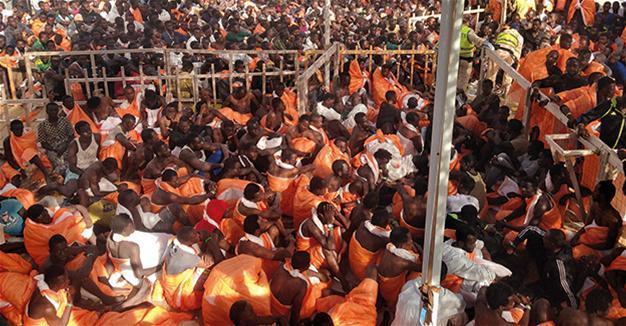Italian Coast Guard on busiest migrant year yet with 180,000 rescued migrants
ROME – Agence France-Presse

AFP photo
It has been a record year for the Italian Coast Guard, with nearly 180,000 people rescued in the Mediterranean, longer days than ever before and, despite their efforts, thousands of victims.In a small room in a soulless ministry building in the south of Rome, red telephones ring and operatives juggle with maps on giant screens on the walls as they coordinate all rescue operations off Libya.
“As soon as someone calls for help, we become conductors,” directing any nearby vessels - be they coastguard, military, private or commercial - to detour to the rescue zone, spokesman Filippo Marini told AFP.
In the gloom of the operations center, SOS calls are reduced to little more than coordinates, handled with military precision.
But the cries of desperate migrants, faces numbed by fear and hands outstretched for help as they slip off sinking dinghies, are not far off, with a video of past rescues playing on a loop on a giant screen in the corridor.
Spread up and down the 8,000 kilometers (4,980 miles) of Italian coastline, the 11,000 members of the coast guard are charged with ensuring maritime safety, protecting the ecosystem and regulating the fishing industry.
They traditionally survey an area of 500,000 square kilometers (200,000 square miles) off Italy’s shores. But an underperforming coast guard in crisis-hit Libya means the Rome Rescue Coordination Centre (MRCC) actually has authority over most of the international waters between both countries.
The seas teem with activity. Around 170,000 people were rescued from migrant boats in 2014, with another 153,000 picked up in 2015 and nearly 180,000 this year - including 4,000 just last week, despite worsening weather at sea.
And the smugglers have upped their game, sending more of their smaller boats - and dinghies rather than wooden vessels - and dispatching lots at the same time. This year saw a 40-percent rise in the number of boats rescued.
“The smugglers used to send bigger boats, each with a satellite phone” to call for aid, said Sergio Liardo, the center’s head.
“Now they set off four boats out with one phone.”
Patrolling vessels can easily find the dinghy with the phone but have to look out for the other three, which can deflate and take water quickly. Drowning is not the only killer here: overcrowding, hypothermia or fuel burns can also finish off in a few hours people weakened by terrible conditions endured trying to get this far.
As well as the thousands of migrants lost in seconds to the waves --sometimes as the rescue crews look helplessly on - the coast guard’s near-daily press releases this year have provided a running tally of corpses discovered aboard dinghies.
The NGO-led rescue vessels patrolling the area have testified to how difficult it can be to spot a dinghy in the immense blue and regularly warn some may be sinking without a trace.
“We cannot rule that out,” Liardo admits.
And while in the past each day of calm seas would see a handful of boats set off, this year saw a series of mass departures.
More than 13,000 people were rescued in one week at the end of May, some 14,000 others in five days of good weather in August - with a record hit with 7,000 people on 53 boats picked up in one day - and 6,000 more on Oct. 3 alone.
















